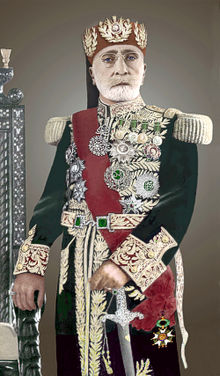Lamine Bey
| Muhammad VIII | |||||
|---|---|---|---|---|---|
| Bey of Tunisia | |||||
 |
|||||
| Reign | 15 May 1943 – 25 July 1957 | ||||
| Predecessor | Muhammad VII | ||||
| Successor |
Husain Bey as Pretender 30 September 1962 And Habib Bourguiba As President of Tunisia |
||||
| Born |
September 4, 1881 Carthage, French Protectorate Tunisia |
||||
| Died | September 30, 1962 (aged 81) Tunis, Tunis Governorate Tunisia |
||||
| Burial | Tomb of King Muhammad al-Amin, Sidi Abdulaziz, La Marsa | ||||
| Spouse | Lalla Janina Beya | ||||
|
|||||
| Name in Arabic | الأمين باي بن محمد الحبيب | ||||
| Dynasty | Husainid Dynasty | ||||
| Father | Muhammad VI al-Habib | ||||
| Mother | Lalla Fatima bint Muhammad | ||||
| Religion | Sunni Islam | ||||
| Full name | |
|---|---|
| Muhammad al-Amin |
Muhammad VIII al-Amin known as Lamine Bey (Carthage 4 September 1881 – Tunis 30 September 1962) (Arabic: الأمين باي بن محمد الحبيب al-Amīn Bāy bin Muḥammad al-Ḥabīb) was the last Bey of Tunisia (15 May 1943 and 20 March 1956).
He was enthroned in unusual circumstances following the removal of his predecessor Moncef Bey by the French Resident General Henri Giraud in 1943. It was not until the latter's death in 1948 that his legitimacy was recognised by the people of Tunisia. He took steps to align himself with the Tunisian national movement against the French protectorate and became in effect its highest representative, not hesitating to face down successive French Residents General. Sidelined by the Neo Destour after he accepted French-initiated reforms in 1954 while leading nationalist activists like Habib Bourguiba were still in prison, he took no part in the negotiations for internal autonomy ratified in 1955, or for independence in 1956. After a short period in which a constitutional monarchy was considered, the new government decided to establish a republic on 25 July 1957. Lamine Bey was turned out of his palace along with his family. Their property was seized and several family members were imprisoned. He ended his days living in a small apartment.
On 19 June 1942 Ahmed Bey died and was succeeded by Moncef Bey. In accordance with tradition on 25 June Moncef Bey named Lamine Bey Bey al-Mahalla, or heir apparent, decorated him with the Ahd El-Amane and made him a Divisional General. A month later he had an opportunity to display his loyalty to his sovereign when he was contacted by one of the court counsellors, General M'hammed Belkhodja. Belkhodja, fearing for his own political future, was trying to persuade the French Resident General Jean-Pierre Esteva to depose Moncef Bey. Lamine Bey however warned the ruler of this conspiracy and Belkhodja was expelled from the palace on 30 July.
...
Wikipedia
